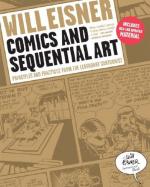
|
| Name: _________________________ | Period: ___________________ |
This test consists of 5 short answer questions, 10 short essay questions, and 1 (of 3) essay topics.
Short Answer Questions
1. In comics, what produces immediate results?
2. How do balloons function for speech in comics?
3. What tendency of the eye is an obstacle in comics?
4. What long Spirit story does Eisner analyze in Chapter 3?
5. What do different renderings require from the viewer?
Short Essay Questions
1. Briefly give a synopsis of Chapter 2.
2. Give a brief summary of the historical evolution of comics according to Chapter 1.
3. Give a brief synopsis of Chapter 4.
4. How does Eisner analyze a long Spirit story, "Foul Play," to show how time is realized through the sequence of events?
5. Where does the emotion or "intuitiveness" of a panel come from?
6. How do people normally measure distance?
7. Why is the repetitiveness of comics compared to a language forming its own grammar?
8. What does communicating ideas involve?
9. Why must the sequential artist deal with humans immersed in space and time?
10. Besides the text in comics, what must the reader/viewer "read"?
Essay Topics
Write an essay for ONE of the following topics:
Essay Topic 1
In Chapter 4, Eisner develops more comparisons between comics and other forms of entertainment. At one point, he suggests that composing a comic strip panel is like designing a theatrical scene, illustration, painting, or mural. Explain Eisner's reasoning using at least four examples from Chapter 4.
Essay Topic 2
Chapter 3 analyzes the relationship between space, time, and visual perspective. Eisner explains that distance is often measured by sight and sound, but it is more difficult to assess time, because it is more illusory. Compile at least three examples provided by Eisner's work and examine the similarities and differences between how time, sight, and sound are measured and expressed in comics.
Essay Topic 3
Eisner argues that comics and images can be "read." Explain the author's reasoning using two examples from the book. Defend or oppose Eisner's position.
|
This section contains 695 words (approx. 3 pages at 300 words per page) |

|




